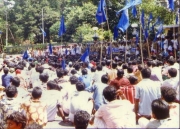
The Ministry of Environment and Forests (MoEF) has issued the draft CRZ Notification, 2010 under the Environment (Protection) Act, 1986 on 15th September, 2010 inviting suggestions and objections from public within 60 days from date of its issue. The following are the new additions to the original 1991 notification:
- Inclusion of ‘Aquatic’ Part: Recognizing the importance of the aquatic area in maintaining the functional integrity including the biodiversity in the coastal areas and waters, the aquatic part (i.e. sea area upto 12 nautical miles and the water area of ‘tidal influenced water bodies’) shall be included.
- Hazard Mapping Mechanism to be revised: Coastal hazard mapping based on tides, waves, sea level rise and shoreline change shall be included and provisions to provide adequate safeguards to infrastructures and habitations of local communities incorporated.
- Preparation of Action Plans: The State and UT Governments shall be directed to prepare an Action Plan to mitigate discharge of untreated waste, effluents, sewage including solid waste in a time bound manner.
- Classification of Erosion-Prone Areas: The Notification will provide for classifying the coastal stretches into “high erosion areas”, “medium erosion area” and “low or stable coast” and no projects would be permitted in the high erosion prone areas, while, in the medium erosion prone areas comprehensive EIA shall be stipulated.
- New Classification Scheme: The proposed classification shall be:
- CRZ-I (ecologically sensitive areas)
- CRZ -II (built up municipal areas)
- CRZ-III (rural areas)
- CRZ-IV (aquatic area) and;
- CRZ-V (areas requiring special consideration). For the islands of Lakshadweep and Andaman & Nicobar a special dispensation has been provided in a draft ‘Island Protection Zone Notification (March) 2010’ (currently inviting suggestions and objections).
- Special Cases: The CRZ notification provides for the uniform regulation of the entire country irrespective of the diversity, socio-economic conditions, developmental pressures etc barring some special cases.
- Deadlines for Grant of Clearance: Procedures have been drawn up and list of documents, studies/ report, maps and the forms that need to be filled to obtain clearance for permissible activities shall be indicated and also fixed time lines shall be provided under the new Notification.
- Clearance process to be harmonised with EIA 2006 standards
- Post Clearance Monitoring and Enforcement: Adequate emphasis is not given for post clearance monitoring of project under the original CRZ Notification. Monitoring procedures and transparency of the compliance to the conditions shall be clearly laid down.
- Preparation of Coastal Zone Management Plans
- Facilities for Fisherfolk: Keeping in view the difficulties faced by fishing communities, basic facilities such as fish drying yards, auction halls, net mending yards, traditional boat building yards, ice crushing units, fish curing facilities etc., shall be provided in the No Development Zone of CRZ-III areas.
The draft notification is available at the website of the Ministry of Environment and Forests here.
FAQs on draft Coastal Regulation Zone notification can be viewed at the MoEF website here.
Critique of a draft Coastal Regulation Zone notification by the Kerala Swathanthra Malsya Thozhilali
Kerala Swathanthra Malsya Thozhilali (Kerala Independent Fishworkers) Federation, a non-party trade union with community-based organisation, working in the unorganised sector of fisheries has rejected the Draft Coastal Regulation Zone Notification, 2010 for two main reasons.
- It does not recognise the inalienable rights of fishing communities to their habitats.
- It does not offer adequate protection to the coastal ecosystem.
The fishing communities had sought their rights to the coast, the notification gave only some concessions. They had not sought concessions, but their right to have settlements on the coast. Up to 50 metres from the high tide level (HTL) of the

CRZ area should be kept free of non-fishery activities. Houses of fishermen within that zone can be rehabilitated within the 50-metre to 500-metre zone. All existing houses of the fishing community within that zone should be regularised.
The notification violated the fundamental principles of coastal protection. There was no logic in permitting activities such as large housing projects, greenfield airports and power plants on the narrow 500-metre strip from the HTL in the CRZ area. In fact, the notification would only serve to displace the fishing communities from the CRZ areas. Activities that require waterfront and foreshore facilities can destroy the coast over time through cumulative impacts.
The special dispensation for Kerala in the notification was essentially to reduce the CRZ from 100 metres to 50 metres for the backwater islands. While this provision outwardly appeared to be one that facilitated the construction of houses for the local communities, it could also facilitate other construction activities for commercial purposes and in the process throw out the fishing communities. Therefore, the dispensation should be limited only to the local fishing communities.
The KMSTF called for a draft Bill on the CRZ that protected the traditional rights and interests of the fishing community and also the coastal environment. The critique can be downloaded here.
A news article on the issue is available on The Hindu website here.
/articles/coastal-regulation-zone-notification-2010-critique-kerala-swathanthra-malsya-thozhilali